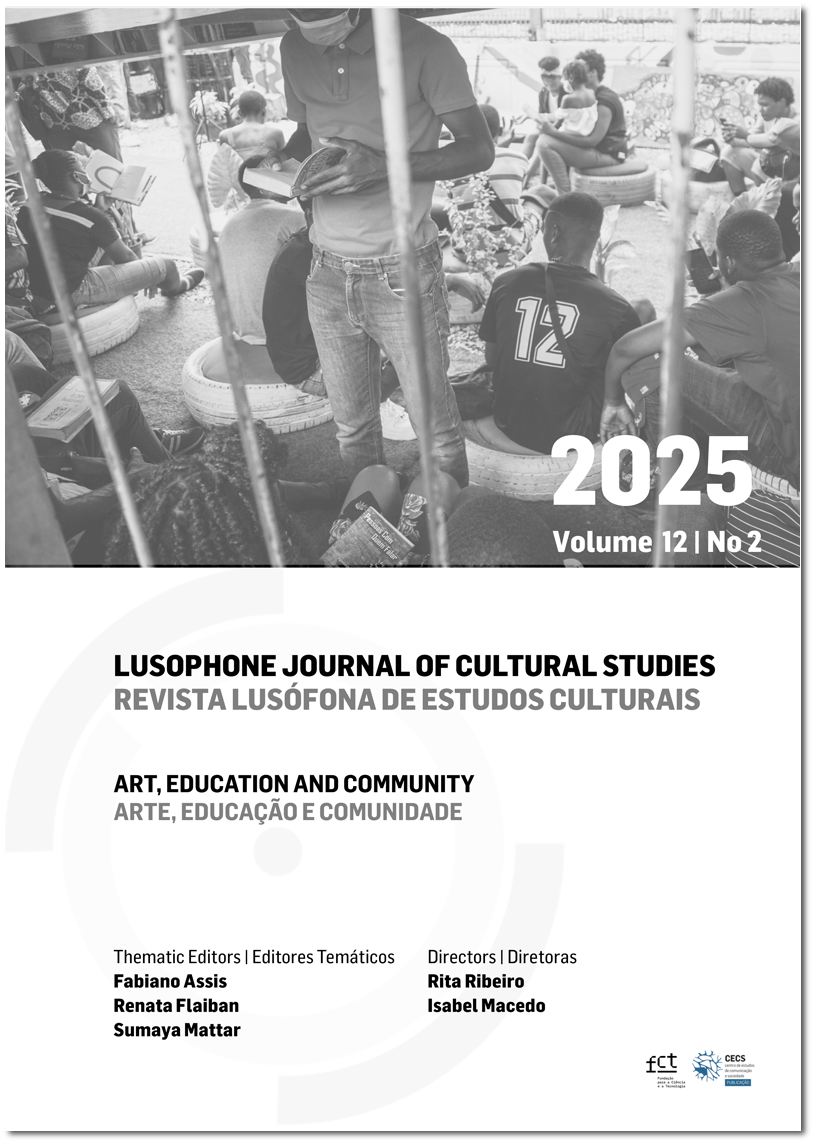The Voices of the Women Who Speak to Our Morro: Art as an Activator of Memories
DOI:
https://doi.org/10.21814/rlec.6539Keywords:
memory, art education, territory, Monte Serrat, female voicesAbstract
This article presents a reflection on the potential of art as an activator of memories within the context of the Monte Serrat community in Florianópolis (Santa Catarina, Brazil), based on a pedagogical experience at Marista Escola Social Lúcia Mayvorne. The study begins with the sensitive listening to the voices of women from the community — mothers, grandmothers, educators, artists — who build and keep alive the collective memory of the territory. The investigation focuses on the interdisciplinary project Mama África, developed with third-year secondary school students, which sought to recover silenced histories and highlight the role of women in community organisation. Drawing on authors such as Paulo Freire (1992) and Célia Xakriabá (2020), the text explores the centrality of territory in educational practice, advocating for a school that is committed to listening, oral expression, and popular knowledge. In this context, art is understood as a language capable of mobilising affections, revealing subjectivities, and giving visibility to historically marginalised experiences. By valuing memory as a constitutive element of identity and collectivity, the work proposes that art contributes to strengthening belonging and autonomy among individuals. Through the practices developed, the study reaffirms the importance of an education that recognises both territory and people as a living body and a producer of knowledge, thereby building relationships between school and community. The experience described points to pedagogical pathways that intertwine memory, art, and territory, envisioning an emancipatory, affective, and transformative education.
Downloads
References
Bosi, E. (2004). Memória e sociedade: Lembranças de velhos. T. A. Queiroz. (Trabalho original publicado em 1987).
Freire, P. (1992). Pedagogia da esperança: Um reencontro com a pedagogia do oprimido. Paz e Terra.
Halbwachs, M. (2006). A memória coletiva (Beatriz Sudou, Trad.). Centauro. (Trabalho original publicado em 1950).
Leal, S. P., & Boakari, F. M. (2023). Do carreiro e da cacimba: Experiências que explicam as relações entre educações e “ser gente” em comunidades. Educação & Sociedade, 44, e250924. https://doi.org/10.1590/ES.250924 DOI: https://doi.org/10.1590/es.250924
Letras.mus.br. (s. d.-a). Diário de um detento: Racionais MC’s. https://www.letras.mus.br/racionais-mcs/63369/
Letras.mus.br. (s. d.-b). Mama África: Chico César. https://www.letras.mus.br/chico-cesar/45197/
Paulista, A. (2013). As mulheres nos movimentos sociais de moradia: A cidade sob uma perspectiva de gênero. Humanidades em Diálogo, 5, 93–108. https://doi.org/10.11606/issn.1982-7547.hd.2013.106242 DOI: https://doi.org/10.11606/issn.1982-7547.hd.2013.106242
Salgado, P. A. D. (2017). Escola, currículo e interdisciplinaridade: Um estudo sobre os pressupostos que constituem a prática interdisciplinar de uma escola de educação básica [Dissertação de mestrado, Universidade de Taubaté].
Santos, L. A. (2009). Do mar ao morro: A geografia histórica da pobreza urbana em Florianópolis [Tese de doutorado, Universidade Federal de Santa Catarina]. Repositório Institucional da UFSC.
Silva, S., S. R. A. (2014). Construções e identidades: Relações entre arte, memória e identidade na educação de jovens e adultos [Dissertação de mestrado, Centro Federal de Educação Tecnológica Celso Suckow da Fonseca].
Silveira, D. (2014, 12 de fevereiro). Embaixada Copa Lord 2014 - Versão Oficial c/ letra [Vídeo]. YouTube. https://www.youtube.com/watch?v=ZmD5kK5y6FQ
Ventura, T. (2021). Reparation struggle: Historical debt and post-colonial justice. Práticas da História: Journal on Theory, Historiography and Uses of the Past, (12), 13–52. https://doi.org/10.48487/pdh.2021.n12.24948
Xakriabá, C. (2020). Amansar o giz. PISEAGRAMA, (14), 110–117.
Downloads
Published
How to Cite
Issue
Section
License
Copyright (c) 2025 Luiza Melo, Tharciana Goulart da Silva

This work is licensed under a Creative Commons Attribution 4.0 International License.
Authors own the copyright, providing the journal with the right of first publication. The work is licensed under a Creative Commons - Atribuição 4.0 Internacional License.












